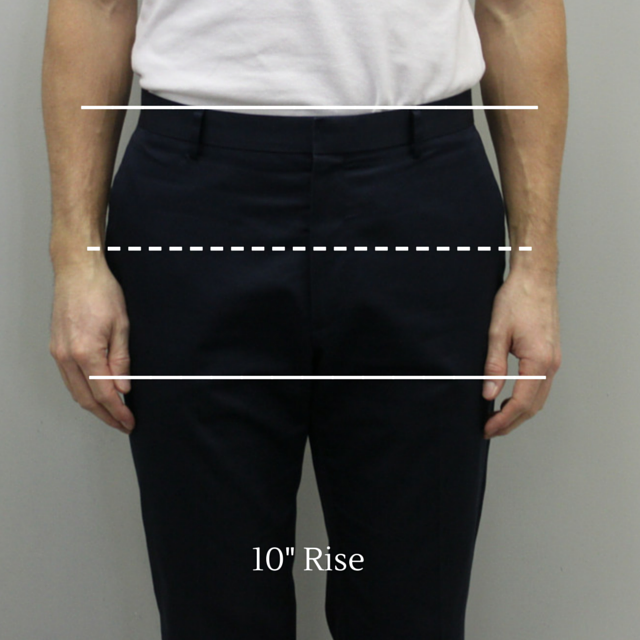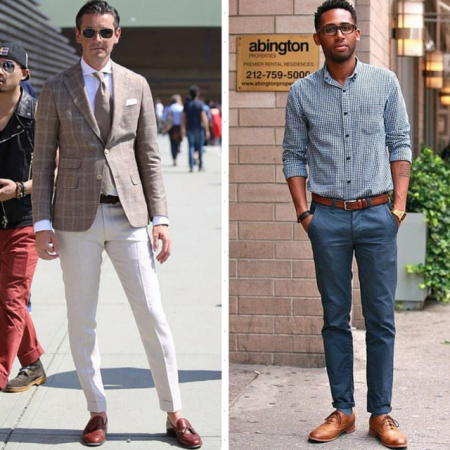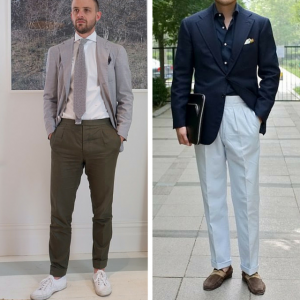Pants are overlooked.
Hopefully following this third and final post of the Perfect Pant series this will no longer be the case. Over the past two weeks the focus has been on what’s happening on the top half of the pant – Part I dealing with the rise while Part II focused on the seat, waist and thigh areas. Today we shift to the bottom half of the pant and explore the importance of cohesively blending the two elements together.
Part III: Get the length and width right.
I’ll start with a blatant but fair generalization – the vast majority of guys wear their pants too loose through the leg and too long. All this does is add unnecessary visual bulk that can make a guy look 10-15 pounds heavier than he actually is. Oddly we have two Hollywood heavyweights to provide us with examples of what not to do:
Where do we start?
1. It’s all about the taper.
Just in case you didn’t know – all pants are tapered. Our bodies are naturally tapered thus clothing needs to follow that form. The question though is how much to taper? There are two keys to this:
The first is to follow the proportions and shape of your body.
The goal is to create a visually pleasing line whereby the thigh, knee and bottom measurements of the pant are balanced proportionally. If the taper is too aggressive then you’ll make your thighs and seat look bigger than they actually are. On the other hand if the taper isn’t enough then the bottom of the pants will be visually heavy making the top look awkwardly small.
In the above images we have four distinct looks that are being pulled off with varying degrees of success. Numbers one and three – classic examples of overaggressive tapering.
#1 – He’s not a big man but he definitely holds his weight in the mid-section. The effect of the aggressive taper is that he appears to have ‘chicken-legs’ in relation to the rest of his body.
#3 – Apologies for his being slightly hidden but I think you can see that he has a fuller chest and quite a developed seat. Instead of balancing out the fact he is top heavy he has emphasized it with the aggressive taper.
The exact opposite has occurred with numbers two and four as they have achieved perfect balance and proportion for their body types.
#2 – He is smaller in terms of height but has some width in his upper body and seat area. With this in mind he has chosen a slightly more relaxed fit through the seat and thigh of the pant; a line that he has maintained with a consistent, soft taper down through the knee toward the pants bottom. The result is total balance and a look that is relaxed yet trim.
#4 – This guy follows the same principle despite his body being a polar opposite with height and skinniness. His level of taper is certainly an aggressive one; this is okay though because he is equally thin through the seat and thighs. The balance is maintained thus the top and bottom sync up with one another.
The second factor comes down to style.
The dominant style of the day is unquestionably a trimmer fit. Based on the factors we just discussed this trim look can manifest itself in varying degrees – from a slimmer look to a slightly fuller look. Honestly assessing your body type and then blending it with your fashion sense is a highly personal choice – there is no right or wrong but at all cost avoid loose and sloppy. Here are some examples to guide you:
#1 – A slightly fuller trim #2 – A slightly slimmer trim
#3 – Trim on a fuller body #4 – Proportionally trim
2. It’s all about the break.
When discussing the break of a pant what we’re essentially referring to the length of your pants. The break is the fold or bend that occurs in the vertical line of the pant when it hits your shoe. The longer the pant the more break there is; conversely a pant that doesn’t hit the shoe has no break at all. Generally there are four breaks as seen in the images below: 1) no-break, 2) quarter-break, 3) half-break and 4) full-break.
Technically there is no right or wrong when it comes to your pant break. It simply comes down to personal preference and what specifically works on your body type. As a general rule of thumb though I recommend guys to start with a quarter to half-break – they represent the best of both worlds and allow guys to get a sense of what they feel comfortable with.
Some loose rules to follow.
The shorter you are the less break you should have – the idea being that an unaltered line of the pant acts to elongate your legs and make you appear leaner and taller.
The taller you are the more break you should have – the idea being that the folds will break up the vertical line thus softening the impact of the height.
For those of you wanting to be fashion forward and have the shorter look please do so with extreme caution. It only works when the width of the bottom is quite narrow – we’re talking between 14-15 inches in total circumference. The key being that as you move the bottom shouldn’t be wildly flopping around – if that is the case then it simply appears that your pants are too short. Here are two examples of it done properly:
And lastly – wear beautiful shoes. My biggest frustration with pants that are too long is that it’s a missed opportunity to show off your shoes. Sloppily burying them under mounds of cloth does nothing for you – polish them up, show them off and set you yourself apart from the pack.
Thanks for reading – I’d really like to hear from you in terms of your thoughts on the entire Perfect Pants series. Was it helpful? Did I miss anything? Are there any other areas you’d appreciate my delving into?
Take care,
Michael





















